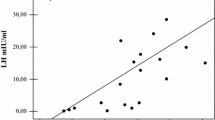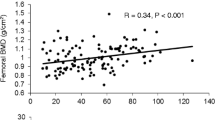Summary
We present the case of a 33-year-old male patient with multiple fractures and typical radiographical and clinical characteristics of osteogenesis imperfecta (OI) type III. Furthermore, the patient has suffered from hypogonadotropic hypogonadism since childhood. On the basis of antiresorptive therapy, no further fractures occurred within several years. Recently, recurrent nontraumatic fractures without bone healing were observed. Decreased bone mineral density was assessed by dual X-ray absorptiometry (DXA). High-resolution peripheral quantitative computed tomography (HR-pQCT) showed impaired trabecular bone structure. Due to recurrent fragility fractures and severe deterioration of bone structure, an osteoanabolic treatment with teriparatide was initiated to potentially stimulate fracture healing and to increase bone formation.
Zusammenfassung
Bei einem 33-jährigen Mann mit multiplen Frakturen wurde anhand von radiologischen und extraskeletalen Merkmalen die Diagnose Osteogenesis imperfecta Typ III nach Sillence gestellt. Seit der Kindheit besteht zusätzlich ein Hypogonadismus bei Hypophyseninsuffizienz. Nach mehrjähriger antiresorptiver Therapie und frakturfreiem Intervall traten rezidivierende atraumatische Femurfrakturen ohne adäquate Frakturheilung auf. Neben hochgradig osteoporotischen Knochendichtewerten in der DXA-Messung zeigte sich ein trabekulärer Strukturdefekt. Zur Frakturkonsolidierung und Verbesserung der Knochenmikroarchitektur wurde eine osteoinduktive Therapie mittels Teriparatid begonnen.



Similar content being viewed by others
References
Lindahl K, Langdahl B, Ljunggren O, Kindmark A. Treatment of osteogenesis imperfecta in adults. Eur J Endocrinol. 2014;171:R79–90.
Garbes L, Kim K, Riess A, Hoyer-Kuhn H, Beleggia F, Bevot A, et al. Mutations in SEC24D, encoding a component of the COPII machinery, cause a syndromic form of osteogenesis imperfecta. Am J Hum Genet. 2015;96:432–9.
Forlino A, Cabral WA, Barnes AM, Marini JC. New perspectives on osteogenesis imperfecta. Nat Rev Endocrinol. 2011;7:540–57.
Chevrel G, Schott AM, Fontanges E, Charrin JE, Lina-Granade G, Duboeuf F, et al. Effects of oral alendronate on BMD in adult patients with osteogenesis imperfecta: a 3-year randomized placebo-controlled trial. J Bone Miner Res. 2006;21:300–6.
Kocijan R, Muschitz C, Fahrleitner-Pammer A, Amrein K, Pietschmann P, Haschka J, et al. Serum sclerostin levels are decreased in adult patients with different types of osteogenesis imperfecta. J Clin Endocrinol Metab. 2014;99:E311–9.
Fritez N, Sobrier ML, Iraqi H, Vie-Luton MP, Netchine I, El Annas A, et al. Molecular screening of a large cohort of Moroccan patients with congenital hypopituitarism. Clin Endocrinol (Oxf). 2015;82:876–84.
Mehta A, Hindmarsh PC, Mehta H, Turton JP, Russell-Eggitt I, Taylor D, et al. Congenital hypopituitarism: clinical, molecular and neuroradiological correlates. Clin Endocrinol (Oxf). 2009;71:376–82.
Wuster C, Abs R, Bengtsson BA, Bennmarker H, Feldt-Rasmussen U, Hernberg-Stahl E, et al. The influence of growth hormone deficiency, growth hormone replacement therapy, and other aspects of hypopituitarism on fracture rate and bone mineral density. J Bone Miner Res. 2001;16:398–405.
Vieira da Costa J, Pereira-Lima JF, da Costa Oliveira M. Bone mineral density in early-onset hypogonadism and the effect of hormonal replacement. J Clin Densitom. 2004;7:334–40.
Paterson CR, McAllion S, Stellman JL. Osteogenesis imperfecta after the menopause. N Engl J Med. 1984;310:1694–6.
Hald JD, Evangelou E, Langdahl BL, Ralston SH. Bisphosphonates for the prevention of fractures in osteogenesis imperfecta: meta-analysis of placebo-controlled trials. J Bone Miner Res. 2015;30:929–33.
Kocijan R, Haschka J, Muschitz C, Trubrich A, Patsch J, Resch H. Enhanced callus formation after six weeks of parathyroid hormone treatment in a man with multiple pelvic fractures and osteogenesis imperfecta type IV. J Bone Joint Surg Am. 2012;2(4):e74. http://dx.doi.org/10.2106/JBJS.CC.L.00042.
Orwoll ES, Shapiro J, Veith S, Wang Y, Lapidus J, Vanek C, et al. Evaluation of teriparatide treatment in adults with osteogenesis imperfecta. J Clin Invest. 2014;124:491–8.
Gatti D, Rossini M, Viapiana O, Povino MR, Liuzza S, Fracassi E, et al. Teriparatide treatment in adult patients with osteogenesis imperfecta type I. Calcif Tissue Int. 2013;93:448–52.
Antoniazzi F, Monti E, Venturi G, Franceschi R, Doro F, Gatti D, et al. GH in combination with bisphosphonate treatment in osteogenesis imperfecta. Eur J Endocrinol. 2010;163:479–87.
O’Halloran DJ, Tsatsoulis A, Whitehouse RW, Holmes SJ, Adams JE, Shalet SM. Increased bone density after recombinant human growth hormone (GH) therapy in adults with isolated GH deficiency. J Clin Endocrinol Metab. 1993;76:1344–8.
Scott CI, Mengel MC, Lawrence GD, Schultz KT, Edgar PJ. Osteogenesis imperfecta and hypopituitarism in two unrelated males. Birth Defects Orig Artic Ser. 1971;7:259–62.
Kocijan R, Muschitz C, Haschka J, Hans D, Nia A, Geroldinger A, et al. Bone structure assessed by HR-pQCT, TBS and DXL in adult patients with different types of osteogenesis imperfecta. Osteoporos Int. 2015. [Epub ahead of print].
Author information
Authors and Affiliations
Corresponding author
Rights and permissions
About this article
Cite this article
Plachel, F., Renner, U., Kocijan, R. et al. Osteogenesis imperfecta type III and hypogonadotropic hypogonadism result in severe bone loss: a case report. Wien Med Wochenschr 165, 285–289 (2015). https://doi.org/10.1007/s10354-015-0367-4
Received:
Accepted:
Published:
Issue Date:
DOI: https://doi.org/10.1007/s10354-015-0367-4




